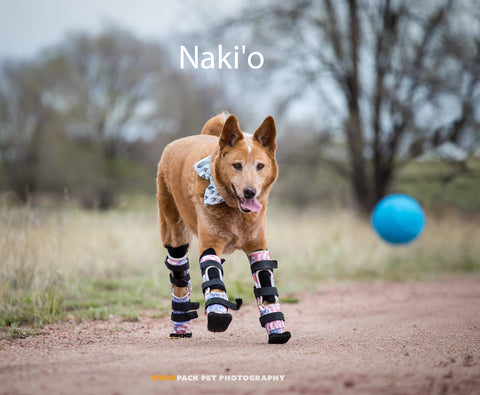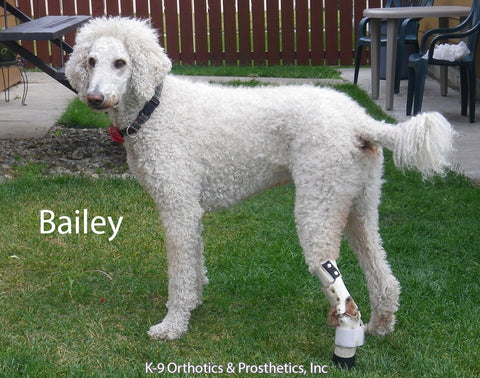Prosthetics - Improving Mobility for Dog Amputees
Prosthetic devices for people have been around for many years, but it is still a relatively new field in the pet world. And just as prosthetic leg devices have helped people get back their mobility, it is now doing the same for our dogs which I happen to think is amazing. Recently I had the privilege of speaking with some experts within the world of dog prosthesis and learned a great deal about the importance of having this option available to improve mobility for dog amputees.
Not all dogs are candidates for a prosthetic unfortunately and a lot has to do with how much of the limb remains and the expectations the owner and doctor have for the dog.

"There are a few factors involved in a patient being a "good candidate." The first question is if the referring veterinarian's and client's goals for the patient are achievable goals. Next, there are residual limb requirements to be able to attach a functional prosthetic. There needs to be at least 30-40% of the radius/ulna remaining for a forelimb prosthetic device and at least 50% of the tibia/fibula remaining for a hindlimb prosthetic device, although, having the entire tibia/fibula remaining is ideal," explains Shawna Anderson, Registered Veterinarian Technician and Case Manager with industry founder Orthopets based in Denver, Colorado.
The residual limb requirements had me thinking back to all the dogs I have seen with amputations and I cannot recall any of those dogs having any portion of their limbs remaining. This I have learned has a lot to do with how these surgeries are conducted. In the human world they preserve as much of the limb as is possible, but in the animal world there is a tendency to remove the entire limb even when this is not necessary.
"Some veterinarians are still unaware of the prosthetic devices available. If a surgeon consults with a prosthesis professional then they can tailor their surgical procedure to ensure that the dog has the right type of amputation for the prosthesis needed. It's a much easier transition for the patient if we can adjust the amputation to the prosthetic," describes Jeff Collins, CEO & President of K-9 Orthotics & Prosthetics based in Nova Scotia, Canada.
The level of awareness, however, does appear to be improving because the number of dogs being helped by prosthetics is increasing indicating that surgical methods are beginning to evolve.
There are of course numerous medical reasons why a full limb amputation may be necessary, but when this is not the case then we as dog parents should speak with our veterinarians prior to the amputation so the surgery can be handled in a way that gives our dogs the best chance of success with a prosthetic device.
 I have personally seen dog amputees and they can do quite well on 3 legs, but long term the impact of compensating for this missing limb can take its toll. Just as humans do when we have an injury, dogs will also compensate with their healthy limbs, but as they get older those healthy limbs can suffer as a result of taking on the weight no longer supported by the missing limb. Prosthetics can be a preventative measure so that when dogs do reach their senior years they are not dealing with joint problems caused from overcompensating.
I have personally seen dog amputees and they can do quite well on 3 legs, but long term the impact of compensating for this missing limb can take its toll. Just as humans do when we have an injury, dogs will also compensate with their healthy limbs, but as they get older those healthy limbs can suffer as a result of taking on the weight no longer supported by the missing limb. Prosthetics can be a preventative measure so that when dogs do reach their senior years they are not dealing with joint problems caused from overcompensating.
According to Jeff Collins, "Getting a prosthetic onto a younger dog can allow it to act as a prophylactic. While the prosthetic has a functional purpose, it is also a prophylactic preventing further damage to the contralateral limb."
In the case of dogs that have a full amputation which excludes them as a candidate for a prosthetic device, Mr. Collins recommends using an orthotic on the opposite leg to prevent that joint from breaking down and creating hyperextension problems as they get older.
A prosthetic is not an off-the-shelf product. Each device is custom fit for the dog and requires a team approach involving patient, vet and prosthetist.
"All devices require a "break in period" to allow the patient to acclimate to the device. We understand why we are putting this device on their limb, but dogs do not. So, we need to take time to introduce it to them and ensure they are identifying the device with something positive, such as going on walks or getting a treat. Adjustments are also a normal part of the process and should be expected by all parties involved. Even though the device is custom fabricated to each patient's limb, we are still placing a foreign object on them and we will need to make minor adjustments to get that perfect fit. Once we have a well fitting device, we are able to slowly work them up to a full-time schedule which is considered AM-PM; off at night like a pair of shoes. This is when the real fun begins for them! This is when off-leash activity can typically occur and they can get back to what they loved to do pre-injury," states Shawna Anderson.
While being able to physically bring your dog in to get fitted is very effective, prosthetics can also be fitted at a distance by obtaining an intricate mold of the amputated leg and measurements to understand the portion of the leg now missing, which the device needs to replace. The greater the height required of the device, the more complicated the process can be.
But what about senior dogs that have amputations late in life? Good news - they too can benefit from a prosthetic limb. As Shawna describes, "We definitely do not see age as a disability. We have many geriatric patients in orthotic and prosthetic devices and they do very well. Their learning curve may be a little longer, but they recognize their improved mobility in their devices and learn to love their devices."
The future for prosthetics is very bright. Not only are veterinarians becoming more aware of what is available for their patients, but the technology to create the artificial limbs is accelerating. One of the most promising areas surrounds 3D printing which could conceivably one day be used to create device components and possibly entire limbs, but it still has a ways to go before that will happen.
According to Orthopets owner and founder Martin Kaufmann, "Currently, the state of the art material to use in the fabrication of an orthosis or prosthesis is polypropylene and laminating carbon-fiber. The polypropylene is extruded in sheets creating a strength and molecular alignment superior to 3D printing capabilities. Carbon-Fiber lamination exceeds all other materials for the ability to create complex shapes with the least amount of strength - to - weight characteristics. No 3D printed materials to date can match these characteristics. Above and beyond this, having the choice to match the most appropriate material selection to the individual patient is critical and not obtainable when considering a 3D printer solution."
At the rate that technology advances, the evolution of prosthetics will continue to move forward creating more opportunities for improving the quality of life for our dog amputees. What also gives me great confidence in this field is understanding the people behind it, many of which are involved because of personal experiences and a genuine love of dogs. They strive to improve not only the devices, but also the awareness within the veterinarian community to ultimately help more and more dogs in need. I for one will be keeping an eye on this industry and should the situation ever call for it, I will be sure to discuss the option of a prosthesis with my veterinarian.
Ann-Marie Fleming is the Founder & CEO of Dog Quality, a provider of products focused on improving the quality of life for older dogs.

